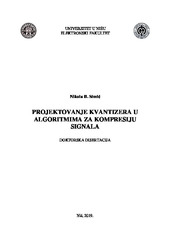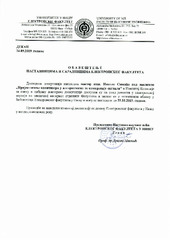Приказ основних података о дисертацији
Projektovanje kvantizera u algoritmima za kompresiju signala
| dc.contributor.advisor | Perić, Zoran | |
| dc.contributor.other | Jovanović, Aleksandra | |
| dc.contributor.other | Nikolić, Jelena | |
| dc.contributor.other | Savić, Milan | |
| dc.contributor.other | Ilić, Anđelija | |
| dc.creator | Simić, Nikola B. | |
| dc.date.accessioned | 2020-02-28T15:09:13Z | |
| dc.date.available | 2020-02-28T15:09:13Z | |
| dc.date.available | 2020-07-03T16:03:22Z | |
| dc.date.issued | 2019-12-27 | |
| dc.identifier.uri | http://eteze.ni.ac.rs/application/showtheses?thesesId=7317 | |
| dc.identifier.uri | https://nardus.mpn.gov.rs/handle/123456789/12167 | |
| dc.identifier.uri | https://fedorani.ni.ac.rs/fedora/get/o:1635/bdef:Content/download | |
| dc.identifier.uri | http://vbs.rs/scripts/cobiss?command=DISPLAY&base=70052&RID=534210966 | |
| dc.description.abstract | Signal compression algorithms represent an indispensable element in many modern digital signal processing systems, especially in multimedia systems where a large amount of data is transferred to a large number of users, whereby it is not of interest to reconstruct the signal without any loss of information at the receiveing end. Generally speaking, signal digitization is performed in three steps – sampling, quantization and encoding. From the standpoint of the development of signal coding and compression algorithms, the most significant step is quantization, which performs discretization of signal amplitudes. The designing of quantizers is not uniquely determined and it depends on the nature of the input signal, the desired quality of the reconstructed signal at the receiving end, as well as the complexity that affects the processing time and the desired compression ratio. Although a large number of quantizer types have been developed so far, it can be said that the area is still insufficiently explored and that there is room for contributions. Signal processing is usually performed in the time or spatial domain, and the most commonly used type of quantizer is a scalar uniform quantizer due to its simplicity. However, advanced coding and compression algorithms use more complex robust and adaptive quantization techniques, they often perform signal transformation into a frequency domain and there is an increasing popularity of utilizing various prediction and machine learning techniques. In this dissertation, an analysis of some of the popular quantization techniques in modern coding and compression algorithms for both continuous and discrete input signals is presented and several hybrid models are proposed in order to obtain some novel lowcomplexity solutions that provide medium and high compression ratios. The experiments are performed by processing a set of natural signals and the representative examples taken are a test speech signal in the case of continuous signals, as well as a set of standard monochromatic images in the case of discrete signals. In addition, Monte Carlo simulations are used to validate some of the developed theoretical models. Performance estimation is performed using objective measures and a theoretical model for performance estimation is developed in the case of the proposed modified block truncation coding algorithm. | en |
| dc.format | application/pdf | |
| dc.language | sr | |
| dc.publisher | Универзитет у Нишу, Електронски факултет | sr |
| dc.relation | info:eu-repo/grantAgreement/MESTD/Technological Development (TD or TR)/32035/RS// | |
| dc.rights | openAccess | en |
| dc.rights.uri | https://creativecommons.org/licenses/by-nc-nd/4.0/ | |
| dc.source | Универзитет у Нишу | sr |
| dc.subject | Kvantizacija | sr |
| dc.subject | Quantization | en |
| dc.subject | Compression | en |
| dc.subject | Source coding | en |
| dc.subject | Transform coding | en |
| dc.subject | Differential coding | en |
| dc.subject | Adaptation | en |
| dc.subject | Modelling | en |
| dc.subject | Image | en |
| dc.subject | Speech | en |
| dc.subject | Kompresija | sr |
| dc.subject | Kodovanje izvora informacija | sr |
| dc.subject | Transformaciono kodovanje | sr |
| dc.subject | Diferencijalno kodovanje | sr |
| dc.subject | Adaptacija | sr |
| dc.subject | Modelovanje | sr |
| dc.subject | Slika | sr |
| dc.subject | Govor | sr |
| dc.title | Projektovanje kvantizera u algoritmima za kompresiju signala | sr |
| dc.type | doctoralThesis | en |
| dc.rights.license | BY-NC-ND | |
| dc.identifier.fulltext | https://nardus.mpn.gov.rs/bitstream/id/52525/Disertacija.pdf | |
| dc.identifier.fulltext | http://nardus.mpn.gov.rs/bitstream/id/52526/Simic_Nikola_B.pdf | |
| dc.identifier.fulltext | https://nardus.mpn.gov.rs/bitstream/id/52526/Simic_Nikola_B.pdf | |
| dc.identifier.fulltext | http://nardus.mpn.gov.rs/bitstream/id/52525/Disertacija.pdf | |
| dc.identifier.rcub | https://hdl.handle.net/21.15107/rcub_nardus_12167 |



